 About GamePeople
About GamePeople
Subscribe to the Family Gamer column:![]() RSS or
RSS or
![]() Newsletter.
Newsletter.
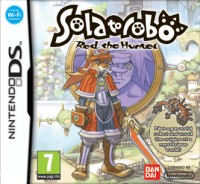
Format:
DS
Genre:
Adventuring
Style:
Realtime
Singleplayer
Thirdperson
Competitive
Further reading:
Zelda Spirit Tracks
Phantom Hourglass
Okamiden
Okamiden
Yoshi's Touch and Go
Advance Wars Dual Strike
WarioWare Touched
Elite Beat Agents
Ghost Trick
Buy/Support:
Support Andy, click to buy via us...
Other GamePeople columnists have reviewed this from their perspective - huh?:
Story Gamer (DS)
Novel Gamer (DS)
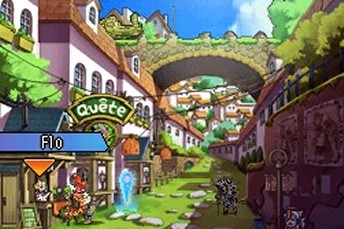
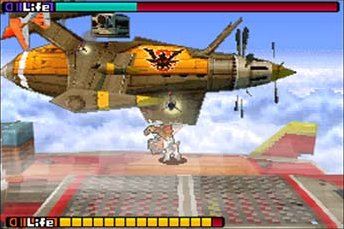
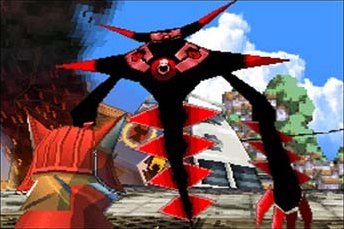
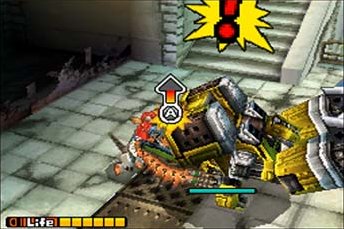
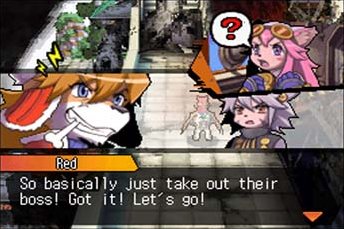
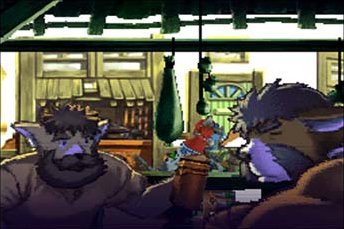
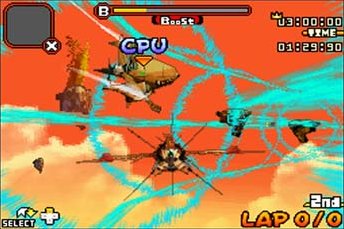
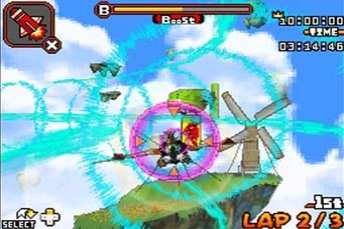

Solatorobo joins a merry band of games that see off the DS in style. The love and attention spent on both the graphics engine and story is are awe inspiring, but it is the playability of Solatorobo that really makes it stick.
It has taken me too long to put pen to paper and write this, not least because Solatorobo is a game that needs to be shared. I don't mean that in the usual videogame way, this is a single player adventure. Rather, it is a memorable experience, like that of a good book or film, that once finished leaves you wanting to go out and buy it for friends, families and passers by on the street.
It's a game released as the DS slowly dwindles and is eclipsed by the 3DS, when other developers have switched attention to Nintendo's rising star and Solatorobo is all the more impressive for this. Attention has been lavished throughout. The visuals not only make a mockery of any perceived need to move on from the DS's graphical prowess, but do so with style and genuine grace.
As you make your way round the island world there is a coherence to every location, cut scene and interior that creates the most convincing world I've explored on the DS. Even the likes of Zelda Spirit Tracks and Phantom Hourglass found it necessary to compromise their aesthetic at times, but Solatorobo refuses to stoop to these tricks of handheld adventures. It joins Okamiden in delivering a true console adventure on a handheld.
Walk behind a building and you are silhouetted out so that you remain visible without obscuring the view. Walk under a bridge and the architecture becomes semi-transparent so you can be seen through it. Make your way up some stairs and the camera pans round to reveal an impressive 3D cityscape. Large foreground objects add a sense of depth as does the varying sounds of the city depending on how close you are to them. It's a graphical engine that squeezes every last drop out of the DS, and has obviously been lovingly optimised in the tradition of (now long forgotten) 16-bit games where graphical horsepower was at a premium.
Although Solatorobo 2 is still only conjecture and rumour, it would be criminal not to capitalise on this investment. I'm sure it won't be long before a Solatorobo sequel appears - and perhaps even other games licensing the technology like they do with the Unreal engine.
Of course, visuals only get you so far. Happily then Solatorobo continues to shine long after its looks have become familiar. For a start there is a Dogtanian and the Three Musketeers kindred spirit running through the heart of the game. This comes not only from the slightly trigger happy approach to discourse (which often descends quickly into fighting) but the French speaking inhabitants and the battling Hounds dressed in red.
Solatorobo continues to shine long after its looks have become familiar.
Beyond these similarities to childhood favourites Solatorobo has a charm and life of its own. A big part of this is the unusual transport and fighting machines you get to pilot. Fighting and puzzle elements revolve around the game's protagonist riding a forklift robot - the DAHAK that introduces a variety of unusual gameplay elements.
Although it is fun to lift and carry objects around the place, the DAHAK's main purpose is fighting and flying. Different moves can be learnt and a flexible power up system (hydraulics, speed, strength and armour) enable you to customise your ride. As with any Japanese adventure game, whether you enjoy this central fighting mechanic will determine well you get on with the game as a whole.
Unlike Okamiden, where I consciously put up with the repetitive arena battles because the rest of the game was so enjoyable, here I was happy to spent as much time fighting as I was exploring and puzzle solving. It's not perfect, there are just a handful of useful moves (at least until Red learn's his Trance abilities), but the execution feels solid and satisfying and did enough to win me over.
As you invest more time in the story, the characters and the narrative provide an ideal excuse to explore the various island worlds. Side quests enable you to purchase upgrades for your robot, and change it from a generic model into something highly tailored and powerful. There are also minigame distractions too, a robot racing game that although not hugely successful in its own right is a welcome addition, and a island hopping robot flying game that integrates a lot better with the rest of the game.
Solatorobo, Okamiden and Ghost Trick that bring the DS project home in suitable style.
The real story of Solatorobo for me is actually one about videogame consoles rather than heroic Dogs in space. It's this stage of a console's life that I really enjoy. Not only is there a great catalogue of early games that pushed the handheld's early success (Yoshi's Touch and Go, Super Mario 64 DS, Advance Wars Dual Strike and WarioWare Touched) and excellent games from its long life (Elite Beat Agents, The World Ends with You, Star Fox Command and Zelda Spirit Tracks) but there is now the icing on the cake. With the hardware's abilities fully understood and at full stretch we get games like Solatorobo, Okamiden and Ghost Trick that bring the DS project home in suitable style.
What's more, take these games to the 3DS and you get a performance boost from the increased power of the new system. Playing them there, and taking advantage of the 3DS Circle pad (which works really well with these DS games) made me more hopeful than ever for the life of the 3DS format. If its games improve as much as they have during the life of the DS, then we are in for some very special experiences over the next few years, and perhaps one of them will be Solatorobo 2.



Andy Robertson writes the Family Gamer column.
"Videogame reviews for the whole family, not just the kids. I dig out videogame experiences to intrigue and interest grownups and children. This is post-hardcore gaming where accessibility, emotion and storytelling are as important as realism, explosions and bravado."
Here are the games I've been playing recently:
© GamePeople 2006-13 | Contact | Huh?

|
Family Video Game Age Ratings | Home | About | Radio shows | Columnists | Competitions | Contact
With so many different perspectives it can be hard to know where to start - a little like walking into a crowded pub. Sorry about that. But so far we've not found a way to streamline our review output - there's basically too much of it. So, rather than dilute things for newcomers we have decided to live with the hubbub while helping new readers find the columnists they will enjoy. |
Our columnists each focus on a particular perspective and fall into one of the following types of gamers:
|